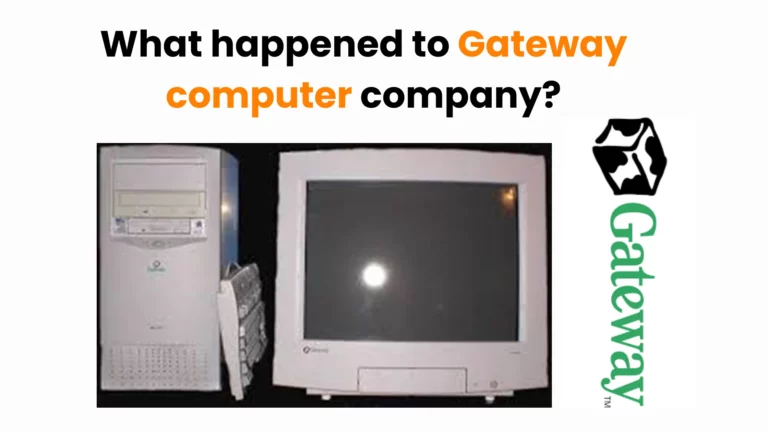Gateway is an American computer company founded in 1985 and headquartered in the United States. It was once famous for its distinctive products, direct-to-consumer sales model, and low-price desktop computers at lower prices.
With a strong brand identity and innovative product design, it became a popular choice among consumers, so much so that Gateway’s sales exceeded $1.1 billion by the end of 1992.
At a period when other computer manufacturers were reporting losses, Gateway’s profits grew over time as the company dominated the mail-order computer industry.
In 1997, Gateway Inc. achieved a revenue of $6.29 billion and a profit of more than $1 billion. By 2004, the company had a 25% share of the retail PC market, ranking third behind Hewlett-Packard (HPQ) and Dell (DELL).
So, where did it all go wrong? What happened to Gateway computer company?
Why did Gateway computers fail?
The decline in the prominence of the Gateway brand can be attributed to a combination of factors, including changes in the technology market, shifts in consumer preferences, and the impact of broader industry trends.
Let’s dive deep into them.
Rapid Expansion
Gateway’s rapid expansion was a contributing factor to its demise. After experiencing extraordinary growth, the company increased the number of executives at the highest levels. It even hired executives from a half-dozen other large computer companies and a new accounting firm to help guide their growth in the proper direction.
Soon began the construction of a massive 44,000-square-foot building in 1991 to improve manufacturing speeds. However, Gateway was unable to keep its quality standards. While sales increased, product quality deteriorated, shipping became difficult, and the product assembly was inadequate to attract customers. Their exceptional success led to an unprecedented disaster.
Related Read: Top Innovations You Must Start Harnessing Today
Market Dynamics and Competition
Gateway’s failure has been linked to several factors, the most prominent was the company’s reluctance to join the laptop market. The firm had a sizable share of the desktop market, but it did not transition to portable computers as quickly as its competitors.
The personal computer market underwent significant changes over the years, with the rise of mobile devices and changes in computing preferences. Competition in the PC market also intensified with the emergence of other well-established brands, such as Dell, HP, and Lenovo.
Furthermore, Gateway attempted to diversify by entering the consumer electronics market. However, its profits were low, which only hampered the company’s margins. In 2002, Gateway started stocking its Gateway Country Stores. Earlier these stores were solely for customers to place orders, but now they stores a variety of consumer electronics. The company enormously impacted the nascent plasma industry by surpassing competitors by hundreds of dollars. The strategy was praised at the moment, but it was a failure.
Related Read: Business Innovation: The What, Why, How, and Where
Shifts in Consumer Preferences
As consumer preferences shifted towards laptops, notebooks, and later, mobile devices, traditional desktop computers—Gateway’s initial focus—became less popular. Gateway, like many other PC manufacturers, started facing challenges in adapting quickly to these changing consumer preferences.
Related Read: How to build an innovation strategy?
Brand Identity and Perception
Over time, the Gateway brand may have struggled to maintain a distinctive and compelling identity in the minds of consumers. A strong and relevant brand identity is crucial in a competitive market, and failure to evolve or resonate with changing consumer expectations resulted in a loss of market share.
Customer Experience
Beginning in late 1992, Gateway was bombarded with customer complaints alleging everything from delivery delays to improperly developed computers. Gateway customers complained that the company’s quality control failed and that its efforts to resolve complaints were insufficient. The business attributed the flaws to the extremely high demand for its products in the fourth quarter of 1992, which made it impossible to fulfill all orders. The company’s negative reputation failed to attract customers, and eventually, the company started to downfall.
When you search the query “why gateway computer”, here’s what you see:

Related Read: 3 Best Continuous Improvement Tools and Processes
Acquisition Strategy
In 2004, the business acquired eMachines, a low-end PC manufacturer. Gateway had lost its shine by that time. The majority of the leadership from the much smaller eMachines was brought in to run the business.
According to Samir Bhavnani, an analyst at Current Analysis, “In reality, it seemed like eMachines was taking over Gateway, with its management structure, the way they marketed themselves and priced themselves.”
In 2005, the newly combined business announced plans to close its retail stores and lay off its workforce. Gateway started to appear on store shelves around that time. And, other consumer electronics were dropped from the product line. It was meant for the company to concentrate more on its core business, PCs.
However, it was too late for the company to survive and gain customer attraction.
Acer’s Integration Strategy
In August 2007, Acer Inc. of Taiwan announced the acquisition of Gateway, Inc., for a US$710 million tender offer. After Acer acquired Gateway, the company integrated Gateway into its broader portfolio of brands. The focus may have shifted more towards Acer’s own brand, impacting the visibility and marketing emphasis on the Gateway brand.
Financial Challenges
Before its acquisition by Acer, Gateway faced financial difficulties. The company had experienced declining sales and struggled to compete effectively in a rapidly changing market. These financial challenges impacted its ability to invest in research and development and marketing efforts to stay competitive.
In Conclusion
Gateway’s corporate sales initiative and expansion into Europe resulted in higher costs in 1993 than the company’s sales and marketing operations in South Dakota. To make up for the impact of those expenses, in October 1993, Gateway unexpectedly announced its plan to sell stock to the public.
In October 1999, AOL invested $800 million in Gateway.net, the internet component of Gateway, Inc. In 2007, Gateway started closing stores as its sales dropped. The company sold itself to Taiwanese computing giant Acer for $710 million in 2007.
When Gateway was sold, GigaOm stated, “The $710 million price tag is quite a comedown from the mid-1990s, when Gateway and Dell (DELL) were spoken of in the same breath and commanded mega-billion dollars in market capitalization.
It’s worth noting that the technology industry is dynamic, and companies often face challenges in adapting to rapid changes in consumer behavior and technology trends. The specific circumstances surrounding Gateway’s decline involve a combination of these factors. What happened to Gateway computer company is a common phenomenon with companies who stop innovating.



